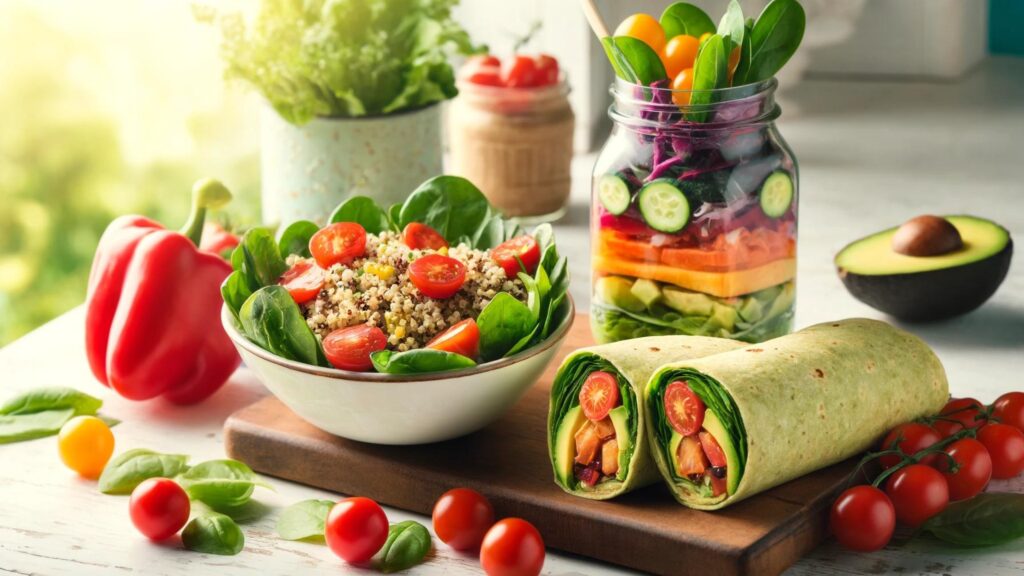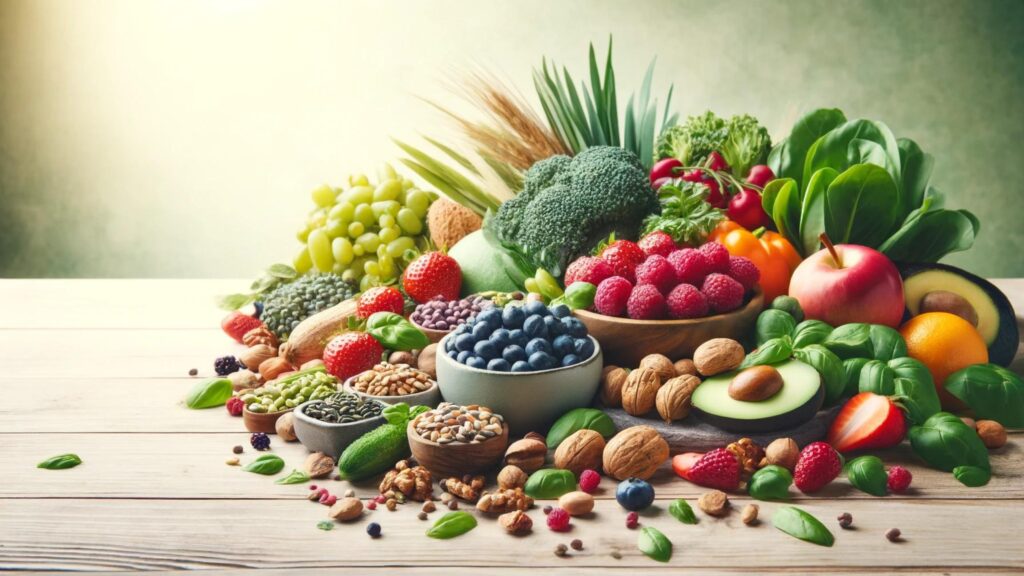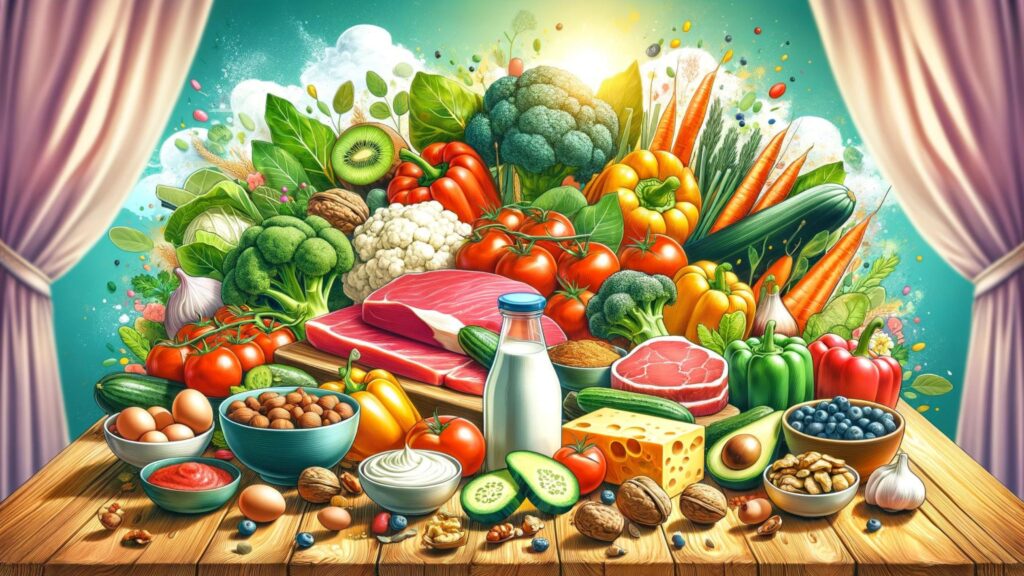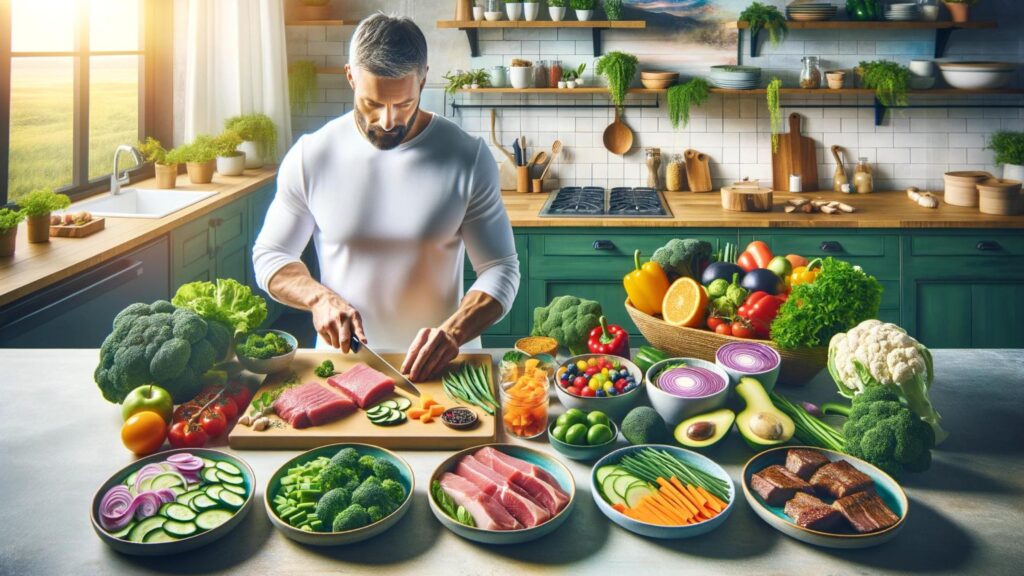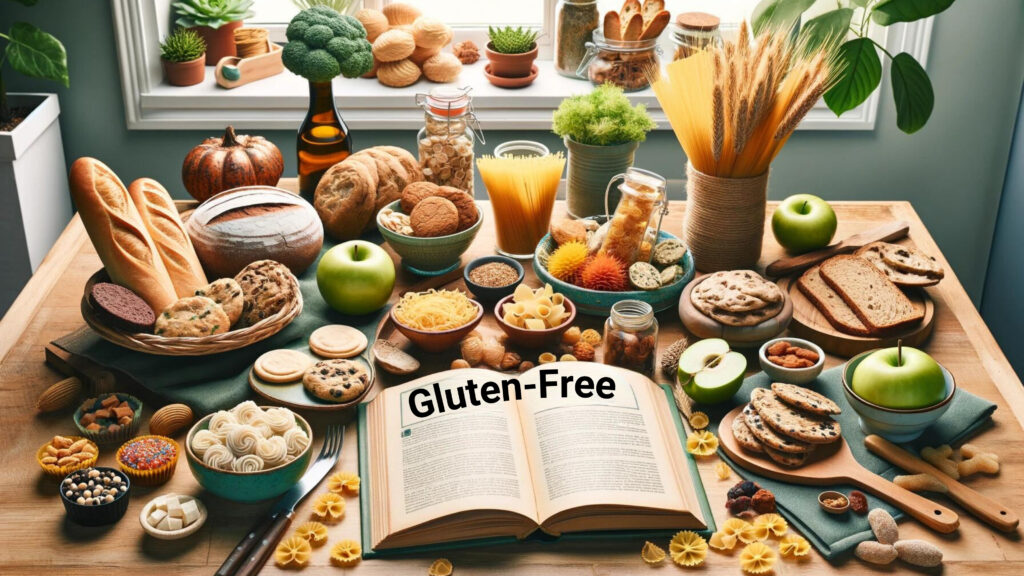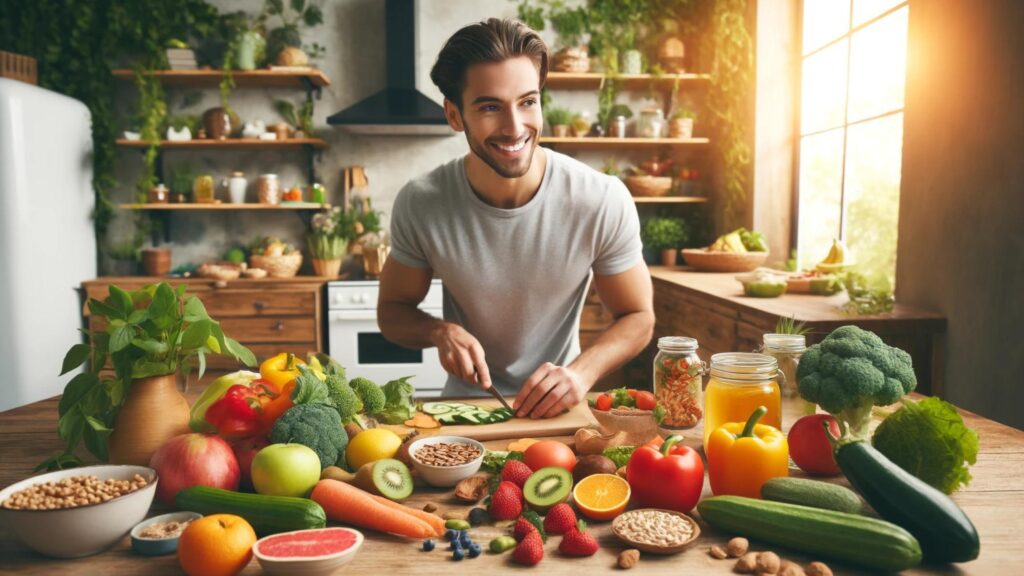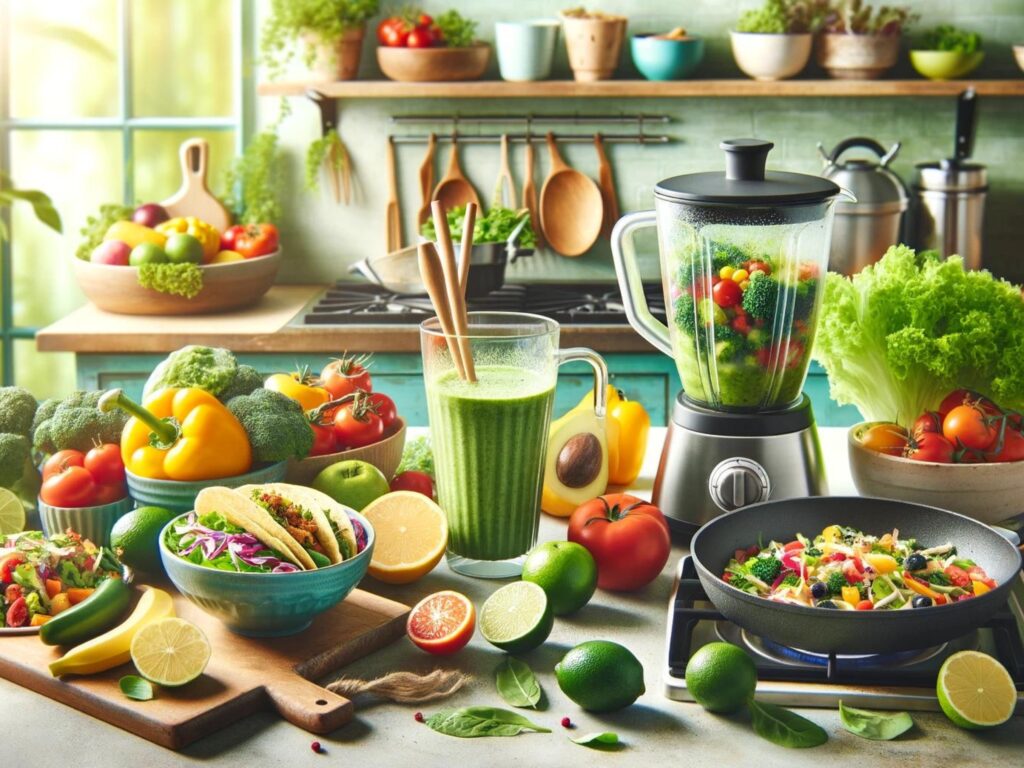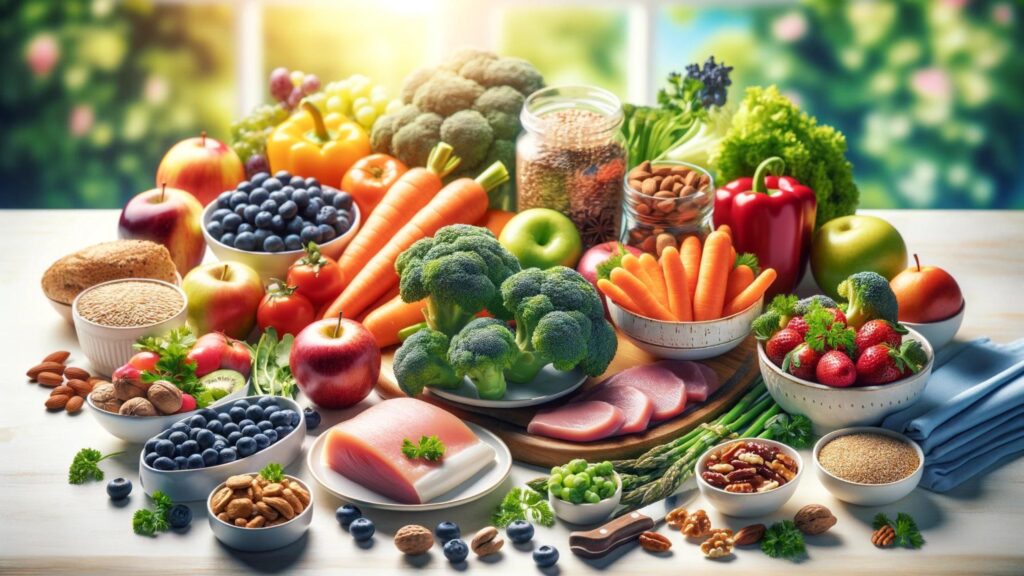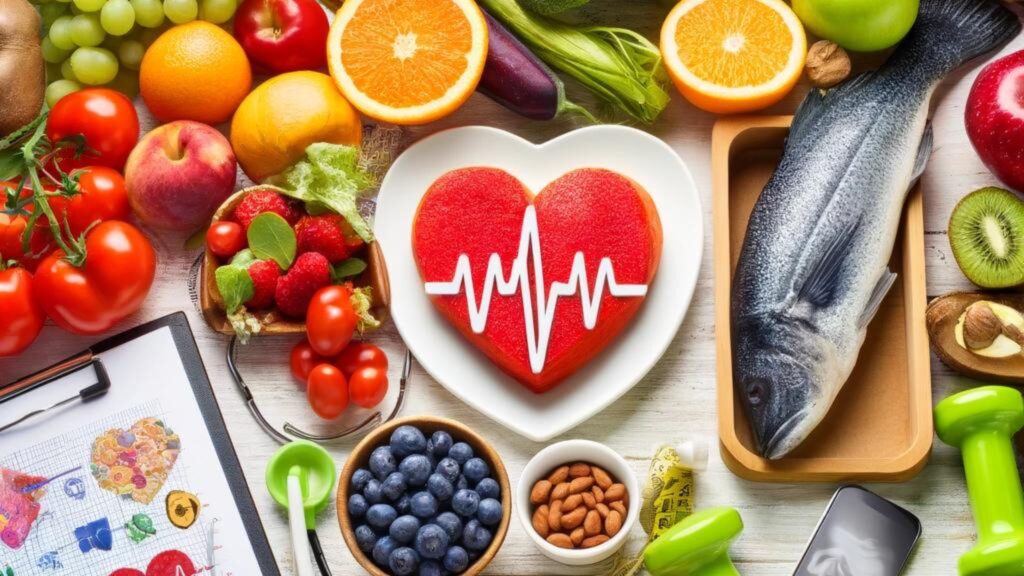Vegan Meals Introduction to Quick Vegan Lunches: Embarking on a culinary journey into quick vegan lunches offers a respite from the mundanity of traditional meal prep. This guide is dedicated to unveiling the simplicity and vibrancy of vegan meals, which provide an efficient and delicious solution to midday dining. For those constantly on the move or seeking a healthier lifestyle, vegan lunches weave together convenience with nutrition, ensuring that every meal is not only quick to prepare but also beneficial to your health and well-being.
The Appeal of Quick Vegan Meals
Quick vegan meals captivate with their blend of rapid preparation and robust flavors. The allure lies in their ability to combine nutrient-dense ingredients into recipes that can be executed in mere minutes, perfect for the bustling lifestyle of the modern eater. These meals transform fresh, accessible ingredients into culinary delights that satiate the palate and invigorate the body, making the vegan approach not just practical but also enjoyable.
Benefits of Choosing Vegan for Lunch
Opting for vegan lunches can significantly augment your health, reduce your carbon footprint, and promote animal welfare. Each plant-based meal contributes to a reduced risk of chronic diseases, including heart disease and diabetes, by focusing on high-fiber, low-fat ingredients that are packed with antioxidants. Moreover, vegan choices tend to be kinder to the planet, minimizing water usage and greenhouse gas emissions compared to meat-based diets.
The Nutrition Behind Vegan Lunches
Delving into the nutrition of vegan lunches reveals a tapestry of benefits tailored to support a healthy lifestyle. These meals are typically lower in calories yet rich in essential nutrients, providing a balanced diet that fuels the body efficiently. The absence of animal products doesn’t make these meals any less nutritious; instead, it opens the door to exploring a diverse range of vitamins and minerals from plants that many might overlook.
Key Nutrients in Vegan Diets
Vegan diets are replete with a variety of key nutrients essential for maintaining health. These include protein sources from legumes, nuts, and seeds; calcium from fortified plant milks and leafy greens; iron from whole grains and dark leafy vegetables; and essential fatty acids from flaxseeds and walnuts. Embracing this diet means engaging in a conscious effort to consume a spectrum of foods that fulfill the body’s nutritional needs.
How Vegan Meals Enhance Daily Energy
Incorporating vegan meals into your daily regimen can lead to an impressive boost in vitality and energy. The natural composition of plant-based foods—rich in complex carbohydrates, fiber, and vital nutrients—facilitates a steadier release of energy throughout the day. This avoids the sharp spikes and drops often associated with heavier, meat-centric meals, thus maintaining consistent energy levels that can enhance overall productivity and well-being.
- The Appeal of Quick Vegan Meals
- Benefits of Choosing Vegan for Lunch
- The Nutrition Behind Vegan Lunches
- Key Nutrients in Vegan Diets
- How Vegan Meals Enhance Daily Energy
- The first quick vegan lunch idea: spicy chickpea wraps
- Ingredients Required for Spicy Chickpea Wraps
- A step-by-step preparation guide.
- Nutritional Analysis of Spicy Chickpea Wraps
- Variations of Spicy Chickpea Wrap
- Adding avocado for extra creaminess.
- Substituting Pita Bread for Low-Carb Options
- Pairing with the Best Vegan Drinks
- The best drinks to pair with spicy flavors
- Quick Vegan Smoothies for Go
- Second Quick Vegan Lunch Idea: Avocado Quinoa Salad
- Ingredients List for Avocado Quinoa Salad
- How to Assemble Your Avocado Quinoa Salad Quickly
- The Health Benefits of Avocado and Quinoa
- Customizing Your Avocado Quinoa Salad
- Topping Variations for Added Flavor
- Making Your Salad a Filling Meal
- Optimal Dressings for Avocado Quinoa Salad
- Homemade Vegan Dressing Recipes
- Store-Bought Vegan Dressings That Work Well
- Third Quick Vegan Lunch Idea: Vegan Sushi Rolls
- Necessary Ingredients for Vegan Sushi
- Simplified Sushi Rolling Techniques
- Exploring Filling Options for Vegan Sushi
- Tofu Versus Tempeh: Which is Better?
- Seasonal Vegetables for Added Crunch
- Sauces and dips for vegan sushi
- Creating a Quick Vegan Soy Sauce Alternative
- Flavorful Vegan Spicy Mayo Recipe
- Combining Vegan Meals with Lifestyle
- Aligning vegan lunch ideas with fitness goals
- Vegan meals for busy professionals
- Tips for Preparing Vegan Meals Quickly
- Kitchen Tools That Speed Up Preparation
- How to Pre-Cook Ingredients for the Entire Week
- Shopping List for Weekly Vegan Lunches
- Essential Ingredients to Always Have on Hand
- How to Shop Efficiently and Economically
- Maintaining Variety in Your Vegan Lunch Routine
- Mixing and Matching Ingredients for New Flavors
- Seasonal Recipes to Keep Things Exciting
- Understanding the Impact of Vegan Meals on Health
- Long-Term Benefits of a Vegan Diet
- Immediate Effects of Switching to Vegan Lunches
- Sustainability and Vegan Meals
- How Vegan Choices Affect the Environment
- Supporting Local and Sustainable Agriculture through Veganism
- Community and Vegan Eating
- Joining Local Vegan Groups for Support
- Sharing Vegan Meals with Friends and Colleagues
- Technology and Vegan Meal Prep
- Apps and Resources to Simplify Vegan Cooking
- Online Communities for Vegan Recipe Sharing
- The Role of Spices and Herbs in Vegan Lunches
- Must-Have Spices for Every Vegan Pantry
- Growing Your Own Herbs for Fresher Flavors
- Allergy Considerations in Vegan Meals
- Identifying Common Allergens in Vegan Recipes
- Safe Substitutions for Allergy-Sensitive Diets
- Kids and Vegan Lunches
- Adapting Vegan Meals for Younger Palates
- Quick Vegan Snacks for Kids
- The Importance of Presentation in Vegan Meals
- Making Your Vegan Dishes Look as Good as They Taste
- Quick Plating Tips for Attractive Vegan Meals
- Seasonal Vegan Lunch Ideas
- Time-Saving Techniques for Vegan Cooking
- Frequently Asked Questions About Vegan Foods
- Conclusion
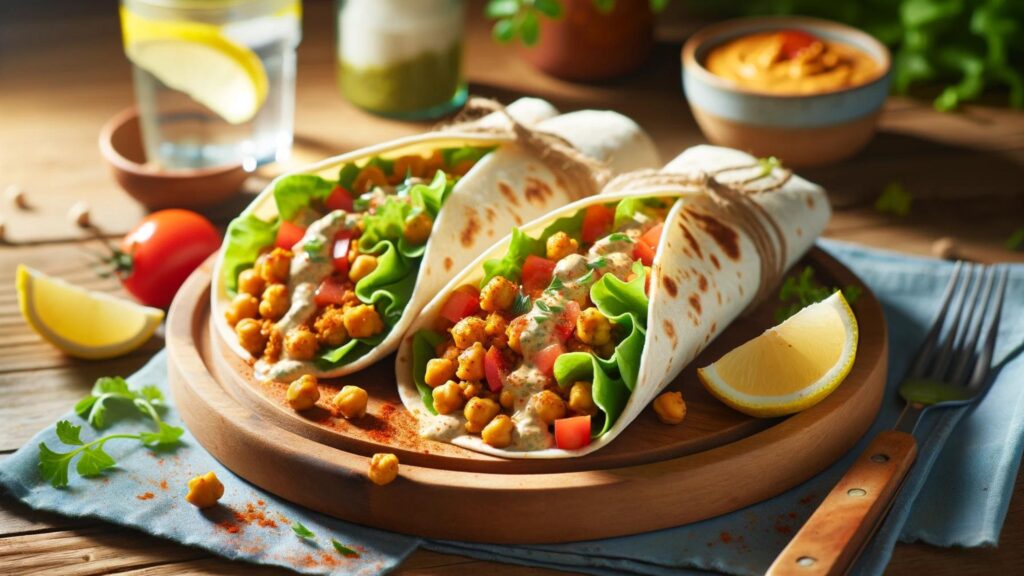
The first quick vegan lunch idea: spicy chickpea wraps
Spicy chickpea wraps are a delectable combination of tastes packed in handy packaging, ideal for a fast vegan lunch. This recipe not only pleases the palette with its bold spices and substantial chickpeas, but it also appeals to individuals with busy schedules who have little time for extensive dinner preparation. Spicy chickpea wraps contain the essence of fast, healthy eating, offering a surge of energy and nutrients with each mouthful.
Ingredients Required for Spicy Chickpea Wraps
To make spicy chickpea wraps, you will need canned chickpeas, fresh garlic, tahini, lemon juice, cumin, chili powder, salt, pepper, fresh veggies such as tomatoes and lettuce, and whole wheat tortillas. This combination of ingredients creates a wrap that is both healthy and flavorful.
A step-by-step preparation guide.
- Prepare the chickpea filling: Drain and rinse the chickpeas. In a pan, heat a little olive oil and sauté the minced garlic until fragrant. Add the chickpeas, tahini, lemon juice, cumin, and chili powder, and mash until well combined.
- Warm the Tortillas: In a separate skillet, lightly toast the tortillas until they are malleable.
- To make the wraps, spread the chickpea mixture down the middle of each tortilla. Top with chopped lettuce, diced tomatoes, and any other desired veggies.
- Roll and Serve: Roll the tortillas tightly to surround the contents. Slice in half and serve immediately, or wrap in foil for a portable lunch.
Nutritional Analysis of Spicy Chickpea Wraps
Spicy chickpea wraps are packed full of minerals. Chickpeas include a lot of protein and fiber, which are good for muscular health and digestion. The inclusion of fresh veggies boosts the vitamin and mineral content, giving these wraps a complete meal with advantages ranging from enhanced metabolism to higher energy levels.
Variations of Spicy Chickpea Wrap
The flexibility of spicy chickpea wraps explains their versatility. Experiment with various greens, such as spinach or arugula, for a nutritious boost, or add a dash of spicy sauce or a sprinkle of vegan cheese for more flavor. These changes may accommodate individual taste preferences while maintaining the meal’s nutritional integrity.
Adding avocado for extra creaminess.
Avocado adds an additional layer of creaminess and a rich, buttery texture to your spicy chickpea wraps, which perfectly match the heat from the spices. Avocado is not only tasty, but it also contains essential fats and elements that improve heart health and skin vibrancy.
Substituting Pita Bread for Low-Carb Options
For individuals watching their carbohydrate consumption, replacing regular tortillas with pita bread may provide a lower-carb option without sacrificing flavor or texture. Alternatively, low-carb tortillas or lettuce wraps are fantastic solutions for preserving the dish’s integrity while accommodating dietary restrictions.
Pairing with the Best Vegan Drinks
To improve your spicy chickpea wrap experience, match it with the ideal vegan drink. The correct beverage may help to balance the spiciness and improve the overall flavor of the dish.
The best drinks to pair with spicy flavors
When eating hot foods, choose liquids that will relax your palette. A cold glass of vegan-friendly cucumber, mint, or coconut water may help to relieve the heat and give a pleasant contrast to the wraps’ intensity.
Quick Vegan Smoothies for Go
A simple vegan smoothie may serve as a healthy accompaniment to any meal, particularly spicy chickpea wraps. Blend spinach, banana, almond milk, and a teaspoon of flaxseeds to make a vitamin- and mineral-rich smoothie. This smoothie not only balances the tastes of the meal, but it also increases your daily nutritional intake, making it a healthy and pleasant option for those on the run.
- The Appeal of Quick Vegan Meals
- Benefits of Choosing Vegan for Lunch
- The Nutrition Behind Vegan Lunches
- Key Nutrients in Vegan Diets
- How Vegan Meals Enhance Daily Energy
- The first quick vegan lunch idea: spicy chickpea wraps
- Ingredients Required for Spicy Chickpea Wraps
- A step-by-step preparation guide.
- Nutritional Analysis of Spicy Chickpea Wraps
- Variations of Spicy Chickpea Wrap
- Adding avocado for extra creaminess.
- Substituting Pita Bread for Low-Carb Options
- Pairing with the Best Vegan Drinks
- The best drinks to pair with spicy flavors
- Quick Vegan Smoothies for Go
- Second Quick Vegan Lunch Idea: Avocado Quinoa Salad
- Ingredients List for Avocado Quinoa Salad
- How to Assemble Your Avocado Quinoa Salad Quickly
- The Health Benefits of Avocado and Quinoa
- Customizing Your Avocado Quinoa Salad
- Topping Variations for Added Flavor
- Making Your Salad a Filling Meal
- Optimal Dressings for Avocado Quinoa Salad
- Homemade Vegan Dressing Recipes
- Store-Bought Vegan Dressings That Work Well
- Third Quick Vegan Lunch Idea: Vegan Sushi Rolls
- Necessary Ingredients for Vegan Sushi
- Simplified Sushi Rolling Techniques
- Exploring Filling Options for Vegan Sushi
- Tofu Versus Tempeh: Which is Better?
- Seasonal Vegetables for Added Crunch
- Sauces and dips for vegan sushi
- Creating a Quick Vegan Soy Sauce Alternative
- Flavorful Vegan Spicy Mayo Recipe
- Combining Vegan Meals with Lifestyle
- Aligning vegan lunch ideas with fitness goals
- Vegan meals for busy professionals
- Tips for Preparing Vegan Meals Quickly
- Kitchen Tools That Speed Up Preparation
- How to Pre-Cook Ingredients for the Entire Week
- Shopping List for Weekly Vegan Lunches
- Essential Ingredients to Always Have on Hand
- How to Shop Efficiently and Economically
- Maintaining Variety in Your Vegan Lunch Routine
- Mixing and Matching Ingredients for New Flavors
- Seasonal Recipes to Keep Things Exciting
- Understanding the Impact of Vegan Meals on Health
- Long-Term Benefits of a Vegan Diet
- Immediate Effects of Switching to Vegan Lunches
- Sustainability and Vegan Meals
- How Vegan Choices Affect the Environment
- Supporting Local and Sustainable Agriculture through Veganism
- Community and Vegan Eating
- Joining Local Vegan Groups for Support
- Sharing Vegan Meals with Friends and Colleagues
- Technology and Vegan Meal Prep
- Apps and Resources to Simplify Vegan Cooking
- Online Communities for Vegan Recipe Sharing
- The Role of Spices and Herbs in Vegan Lunches
- Must-Have Spices for Every Vegan Pantry
- Growing Your Own Herbs for Fresher Flavors
- Allergy Considerations in Vegan Meals
- Identifying Common Allergens in Vegan Recipes
- Safe Substitutions for Allergy-Sensitive Diets
- Kids and Vegan Lunches
- Adapting Vegan Meals for Younger Palates
- Quick Vegan Snacks for Kids
- The Importance of Presentation in Vegan Meals
- Making Your Vegan Dishes Look as Good as They Taste
- Quick Plating Tips for Attractive Vegan Meals
- Seasonal Vegan Lunch Ideas
- Time-Saving Techniques for Vegan Cooking
- Frequently Asked Questions About Vegan Foods
- Conclusion
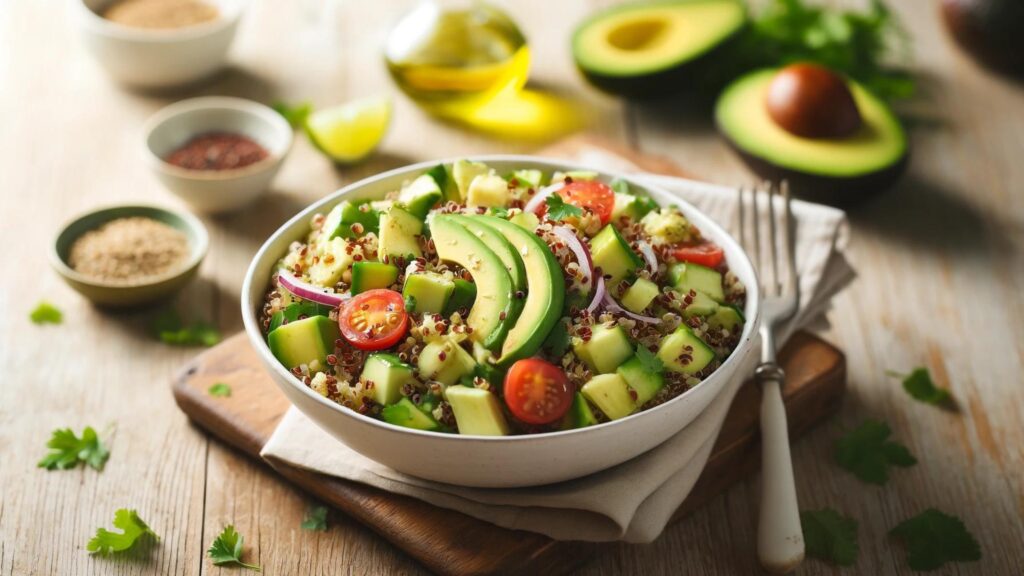
Second Quick Vegan Lunch Idea: Avocado Quinoa Salad
Introducing the Avocado Quinoa Salad—a vibrant, nutrient-dense meal that perfectly encapsulates the essence of quick and healthy vegan dining. This salad combines the creamy texture of avocado with the subtle crunch of quinoa, creating a dish that is not only visually appealing but also packed with essential nutrients, making it an ideal choice for a wholesome lunch.
Ingredients List for Avocado Quinoa Salad
For this delectable salad, you will need:
- 1 cup cooked quinoa, cooled
- 1 ripe avocado, diced
- 1/2 cup cherry tomatoes, halved
- 1/4 cup red onion, finely chopped
- 1/2 cucumber, diced
- A handful of fresh cilantro, chopped
- Juice of one lime
- Salt and pepper to taste
- Optional: red pepper flakes for a bit of spice
How to Assemble Your Avocado Quinoa Salad Quickly
- Combine Ingredients: In a large bowl, toss the cooled quinoa with the avocado, cherry tomatoes, cucumber, and red onion.
- Add Flavor: Sprinkle with fresh cilantro, squeeze in the lime juice, and season with salt, pepper, and optional red pepper flakes.
- Mix Gently: Stir gently to combine, ensuring the avocado maintains its shape.
- Serve: Enjoy immediately, or chill in the refrigerator for a refreshing cold salad.
The Health Benefits of Avocado and Quinoa
Avocado is renowned for its high levels of healthy fats, particularly omega-3 fatty acids, which are crucial for heart health and cognitive function. Quinoa, a complete protein source, provides all nine essential amino acids, making it a staple in plant-based diets. Together, they offer a powerful combination of fats and proteins that support overall health and energy levels.
Customizing Your Avocado Quinoa Salad
This salad is a canvas for your culinary creativity. Consider adding:
- Proteins: Mix in chickpeas or black beans for extra protein.
- Greens: Throw in spinach or arugula for added texture and nutrients.
- Nuts: Sprinkle toasted almonds or walnuts for a crunchy contrast.
Topping Variations for Added Flavor
Enhance your salad by experimenting with various toppings.
- Cheese: Vegan feta or parmesan can add a salty, cheesy flavor without the dairy.
- Fruits: Diced mango or pomegranate seeds can introduce a sweet, tangy profile.
- Herbs: Fresh mint or basil can offer a refreshing twist.
Making Your Salad a Filling Meal
To transform this salad into a hearty meal, bulk it up with additional protein and fiber.
- Grains: Add barley or farro for a more substantial base.
- Legumes: Include lentils or edamame to increase the protein content.
- Veggies: Incorporate roasted sweet potatoes or bell peppers for extra fullness.
Optimal Dressings for Avocado Quinoa Salad
The right dressing can elevate your salad from good to great. Opt for light, citrusy vinaigrettes to enhance the natural flavors of the ingredients without overwhelming them.
Homemade Vegan Dressing Recipes
Creating your own dressings allows for customization and ensures freshness.
- Lime Cilantro Vinaigrette: Blend lime juice, olive oil, cilantro, garlic, and a touch of agave.
- Creamy Tahini Dressing: Whisk together tahini, lemon juice, garlic powder, and water to desired consistency.
Store-Bought Vegan Dressings That Work Well
For those in a rush, several high-quality vegan dressings are available on the market. Look for brands that use organic ingredients and minimal additives to maintain the healthiness of your salad.
- The Appeal of Quick Vegan Meals
- Benefits of Choosing Vegan for Lunch
- The Nutrition Behind Vegan Lunches
- Key Nutrients in Vegan Diets
- How Vegan Meals Enhance Daily Energy
- The first quick vegan lunch idea: spicy chickpea wraps
- Ingredients Required for Spicy Chickpea Wraps
- A step-by-step preparation guide.
- Nutritional Analysis of Spicy Chickpea Wraps
- Variations of Spicy Chickpea Wrap
- Adding avocado for extra creaminess.
- Substituting Pita Bread for Low-Carb Options
- Pairing with the Best Vegan Drinks
- The best drinks to pair with spicy flavors
- Quick Vegan Smoothies for Go
- Second Quick Vegan Lunch Idea: Avocado Quinoa Salad
- Ingredients List for Avocado Quinoa Salad
- How to Assemble Your Avocado Quinoa Salad Quickly
- The Health Benefits of Avocado and Quinoa
- Customizing Your Avocado Quinoa Salad
- Topping Variations for Added Flavor
- Making Your Salad a Filling Meal
- Optimal Dressings for Avocado Quinoa Salad
- Homemade Vegan Dressing Recipes
- Store-Bought Vegan Dressings That Work Well
- Third Quick Vegan Lunch Idea: Vegan Sushi Rolls
- Necessary Ingredients for Vegan Sushi
- Simplified Sushi Rolling Techniques
- Exploring Filling Options for Vegan Sushi
- Tofu Versus Tempeh: Which is Better?
- Seasonal Vegetables for Added Crunch
- Sauces and dips for vegan sushi
- Creating a Quick Vegan Soy Sauce Alternative
- Flavorful Vegan Spicy Mayo Recipe
- Combining Vegan Meals with Lifestyle
- Aligning vegan lunch ideas with fitness goals
- Vegan meals for busy professionals
- Tips for Preparing Vegan Meals Quickly
- Kitchen Tools That Speed Up Preparation
- How to Pre-Cook Ingredients for the Entire Week
- Shopping List for Weekly Vegan Lunches
- Essential Ingredients to Always Have on Hand
- How to Shop Efficiently and Economically
- Maintaining Variety in Your Vegan Lunch Routine
- Mixing and Matching Ingredients for New Flavors
- Seasonal Recipes to Keep Things Exciting
- Understanding the Impact of Vegan Meals on Health
- Long-Term Benefits of a Vegan Diet
- Immediate Effects of Switching to Vegan Lunches
- Sustainability and Vegan Meals
- How Vegan Choices Affect the Environment
- Supporting Local and Sustainable Agriculture through Veganism
- Community and Vegan Eating
- Joining Local Vegan Groups for Support
- Sharing Vegan Meals with Friends and Colleagues
- Technology and Vegan Meal Prep
- Apps and Resources to Simplify Vegan Cooking
- Online Communities for Vegan Recipe Sharing
- The Role of Spices and Herbs in Vegan Lunches
- Must-Have Spices for Every Vegan Pantry
- Growing Your Own Herbs for Fresher Flavors
- Allergy Considerations in Vegan Meals
- Identifying Common Allergens in Vegan Recipes
- Safe Substitutions for Allergy-Sensitive Diets
- Kids and Vegan Lunches
- Adapting Vegan Meals for Younger Palates
- Quick Vegan Snacks for Kids
- The Importance of Presentation in Vegan Meals
- Making Your Vegan Dishes Look as Good as They Taste
- Quick Plating Tips for Attractive Vegan Meals
- Seasonal Vegan Lunch Ideas
- Time-Saving Techniques for Vegan Cooking
- Frequently Asked Questions About Vegan Foods
- Conclusion
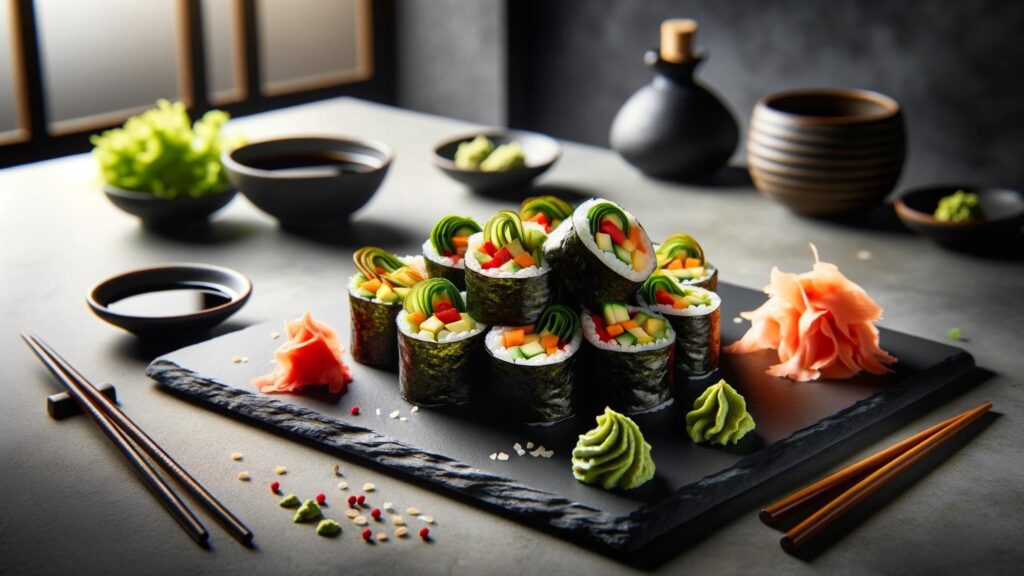
Third Quick Vegan Lunch Idea: Vegan Sushi Rolls
Vegan sushi rolls are a fun and inventive approach to plant-based eating, blending classic Japanese culinary traditions with a contemporary vegan twist. These rolls take a new approach to sushi, substituting traditional fish with vivid veggies like tofu and tempeh, making them both artistic and nutritious options for lunch.
Necessary Ingredients for Vegan Sushi
To craft your vegan sushi rolls, you will need:
- Sushi rice (short-grain rice)
- Rice vinegar
- Nori sheets
- Fillings, such as cucumber, avocado, and bell pepper
- Tofu or tempeh
- For dipping, use soy sauce or tamari.
- Optional additions like wasabi and pickled ginger
Simplified Sushi Rolling Techniques
- Prepare Rice: Rinse your sushi rice under cold water until it runs clear, then cook it according to package instructions.
- Season Rice: Once cooked, mix the rice with a splash of rice vinegar.
- Prepare Fillings: Slice all fillings into long, thin strips.
- Assemble Rolls: Lay out a nori sheet on a bamboo mat and spread a thin layer of rice on the sheet, leaving a small margin at the top to seal the roll.
- Add Fillings: Place your fillings horizontally across the rice.
- Roll: Using the bamboo mat, tightly roll the nori from the bottom up, applying gentle pressure to keep everything compact.
- Seal and Slice: Moisten the top edge of the nori with a little water to seal the roll, then slice into bite-sized pieces with a sharp knife.
Exploring Filling Options for Vegan Sushi
Vegan sushi allows for a plethora of filling combinations. Popular choices include:
- Crunchy Veggies: Carrot, bell pepper, and radish for crisp textures.
- Soft Additions: Avocado and marinated mushrooms for a buttery feel.
- Protein: scrambled tofu or smoked tempeh for a satisfying bite.
Tofu Versus Tempeh: Which is Better?
Choosing between tofu and tempeh depends on personal preference and dietary goals.
- Tofu: Softer and smoother, it absorbs flavors well, making it ideal for more delicate sushi rolls.
- Tempeh: firmer and grainier with a nuttier flavor, offering a heartier texture and enhanced nutritional profile.
Seasonal Vegetables for Added Crunch
Incorporating seasonal vegetables not only enhances the crunch but also optimizes nutritional content and flavor. Spring might feature asparagus and radishes; summer brings bell peppers and cucumbers; fall is perfect for sweet potatoes; and winter introduces carrots and beets.
Sauces and dips for vegan sushi
Enhance your vegan sushi experience with a variety of sauces and dips.
- Traditional Soy Sauce: Always a Staple.
- Add a kick to your vegan mayo by mixing it with Sriracha.
- Sweet Teriyaki: For those who prefer a hint of sweetness.
Creating a Quick Vegan Soy Sauce Alternative
For a soy-free alternative, try mixing:
- 1 part molasses
- 1 part tamarind paste
- 2 parts water
- A pinch of sea salt Simmer until thickened into a rich, flavorful sauce.
Flavorful Vegan Spicy Mayo Recipe
Whisk together to create a simple vegan spicy mayo:
- Vegan mayonnaise
- Sriracha or chili paste, adjusted according to taste
- A squeeze of lime juice for extra zing
Combining Vegan Meals with Lifestyle
Vegan sushi is more than just food; it’s a lifestyle choice that supports health, environmental consciousness, and ethical eating habits. It’s perfect for those who are health-conscious but also crave culinary creativity in their meals.
Aligning vegan lunch ideas with fitness goals
Vegan sushi is an excellent fit for fitness enthusiasts. Rich in proteins and complex carbohydrates while low in fats, it provides the necessary energy without being overly heavy, supporting both muscle repair and endurance.
Vegan meals for busy professionals
For professionals on the go, vegan sushi rolls are an excellent meal prep option. Even on the busiest days, you can make them in advance, store them in the fridge, and consume them easily, demonstrating that quick, nutritious meals can also be delicious and satisfying.
- The Appeal of Quick Vegan Meals
- Benefits of Choosing Vegan for Lunch
- The Nutrition Behind Vegan Lunches
- Key Nutrients in Vegan Diets
- How Vegan Meals Enhance Daily Energy
- The first quick vegan lunch idea: spicy chickpea wraps
- Ingredients Required for Spicy Chickpea Wraps
- A step-by-step preparation guide.
- Nutritional Analysis of Spicy Chickpea Wraps
- Variations of Spicy Chickpea Wrap
- Adding avocado for extra creaminess.
- Substituting Pita Bread for Low-Carb Options
- Pairing with the Best Vegan Drinks
- The best drinks to pair with spicy flavors
- Quick Vegan Smoothies for Go
- Second Quick Vegan Lunch Idea: Avocado Quinoa Salad
- Ingredients List for Avocado Quinoa Salad
- How to Assemble Your Avocado Quinoa Salad Quickly
- The Health Benefits of Avocado and Quinoa
- Customizing Your Avocado Quinoa Salad
- Topping Variations for Added Flavor
- Making Your Salad a Filling Meal
- Optimal Dressings for Avocado Quinoa Salad
- Homemade Vegan Dressing Recipes
- Store-Bought Vegan Dressings That Work Well
- Third Quick Vegan Lunch Idea: Vegan Sushi Rolls
- Necessary Ingredients for Vegan Sushi
- Simplified Sushi Rolling Techniques
- Exploring Filling Options for Vegan Sushi
- Tofu Versus Tempeh: Which is Better?
- Seasonal Vegetables for Added Crunch
- Sauces and dips for vegan sushi
- Creating a Quick Vegan Soy Sauce Alternative
- Flavorful Vegan Spicy Mayo Recipe
- Combining Vegan Meals with Lifestyle
- Aligning vegan lunch ideas with fitness goals
- Vegan meals for busy professionals
- Tips for Preparing Vegan Meals Quickly
- Kitchen Tools That Speed Up Preparation
- How to Pre-Cook Ingredients for the Entire Week
- Shopping List for Weekly Vegan Lunches
- Essential Ingredients to Always Have on Hand
- How to Shop Efficiently and Economically
- Maintaining Variety in Your Vegan Lunch Routine
- Mixing and Matching Ingredients for New Flavors
- Seasonal Recipes to Keep Things Exciting
- Understanding the Impact of Vegan Meals on Health
- Long-Term Benefits of a Vegan Diet
- Immediate Effects of Switching to Vegan Lunches
- Sustainability and Vegan Meals
- How Vegan Choices Affect the Environment
- Supporting Local and Sustainable Agriculture through Veganism
- Community and Vegan Eating
- Joining Local Vegan Groups for Support
- Sharing Vegan Meals with Friends and Colleagues
- Technology and Vegan Meal Prep
- Apps and Resources to Simplify Vegan Cooking
- Online Communities for Vegan Recipe Sharing
- The Role of Spices and Herbs in Vegan Lunches
- Must-Have Spices for Every Vegan Pantry
- Growing Your Own Herbs for Fresher Flavors
- Allergy Considerations in Vegan Meals
- Identifying Common Allergens in Vegan Recipes
- Safe Substitutions for Allergy-Sensitive Diets
- Kids and Vegan Lunches
- Adapting Vegan Meals for Younger Palates
- Quick Vegan Snacks for Kids
- The Importance of Presentation in Vegan Meals
- Making Your Vegan Dishes Look as Good as They Taste
- Quick Plating Tips for Attractive Vegan Meals
- Seasonal Vegan Lunch Ideas
- Time-Saving Techniques for Vegan Cooking
- Frequently Asked Questions About Vegan Foods
- Conclusion
Tips for Preparing Vegan Meals Quickly
Mastering the art of quick vegan meal preparation hinges on efficient techniques and smart planning. By focusing on simple recipes with minimal ingredients and leveraging time-saving kitchen gadgets, you can whip up nutritious vegan meals in no time. Prioritize dishes that require less cooking time and can be made in large batches for multiple meals.
Kitchen Tools That Speed Up Preparation
Investing in the right kitchen tools can significantly reduce meal prep time. A food processor can quickly chop vegetables, a high-speed blender can make smoothies in seconds, and a pressure cooker or an instant pot can dramatically cut down on cooking times for grains and legumes. A good set of sharp knives and a mandoline slicer are also invaluable for efficient chopping and slicing.
How to Pre-Cook Ingredients for the Entire Week
Batch cooking is a game-changer for meal prep. On your designated cooking day:
- Cook Grains and Legumes: Prepare quinoa, rice, lentils, or chickpeas in large quantities.
- Roast Vegetables: Batch roast vegetables like broccoli, sweet potatoes, and peppers. They can easily be reheated or served cold in salads.
- Prepare Proteins: Bake or grill tofu or tempeh for quick protein additions.
- Make Sauces and Dressings: Preparing dressings and sauces in advance can save a lot of time during the week.
Shopping List for Weekly Vegan Lunches
Creating a shopping list specific to your meal plan can streamline your grocery shopping and ensure you have everything you need. Include a variety of fruits, vegetables, whole grains, proteins (like tofu and tempeh), and staples like nuts, seeds, and plant-based milks. Don’t forget essential spices and condiments for flavor.
Essential Ingredients to Always Have on Hand
Keeping a well-stocked pantry can make vegan cooking much easier. Essentials include:
- Grains: Rice, quinoa, oats
- Legumes: Lentils, chickpeas, and black beans
- Nuts and Seeds: Almonds, chia seeds, and Flaxseeds
- Condiments: Soy sauce, nutritional yeast, vinegar
- Spices: Garlic powder, cumin, chili flakes
How to Shop Efficiently and Economically
To shop efficiently, stick to your list and avoid impulse buys. Buy in bulk where possible and choose generic brands for basic ingredients. Look for sales and seasonal produce, which is usually cheaper and at its peak flavor. Consider subscribing to a local CSA (Community Supported Agriculture) box for fresh, local produce at a good price.
Maintaining Variety in Your Vegan Lunch Routine
Avoid meal fatigue by rotating your recipes and trying new dishes. Use themed days, like “Mexican Monday” or “Thai Thursday,” to introduce variety without overwhelming your schedule. Experiment with different spices and international ingredients to keep your meals interesting and diverse.
Mixing and Matching Ingredients for New Flavors
Get creative by mixing and matching pantry staples to discover new flavor combinations. Combine grains like barley with spices like turmeric, or mix sweet with savory, such as adding dried fruits to a savory salad. The key is to balance textures and flavors for satisfying meals.
Seasonal Recipes to Keep Things Exciting
Embrace the seasons by incorporating seasonal ingredients into your meals, which can inspire new recipes and bring fresh flavors to your table. In the spring, make dishes with asparagus and peas; in summer, use tomatoes and berries; in autumn, turn to squash and apples; and in winter, utilize root vegetables and hearty greens.
Understanding the Impact of Vegan Meals on Health
Adopting vegan meals can significantly influence both physical and mental health. By eliminating animal products, vegan diets often result in lower cholesterol levels, reduced blood pressure, and decreased risk of heart disease. Additionally, the high intake of fruits, vegetables, nuts, seeds, and whole grains associated with vegan diets can lead to improved digestion, more stable blood sugar levels, and a healthier body weight.
Long-Term Benefits of a Vegan Diet
The long-term benefits of a vegan diet extend beyond immediate health improvements. Individuals who follow a vegan lifestyle typically experience lower risks of developing chronic diseases such as type 2 diabetes, certain cancers, and heart disease. Moreover, vegan diets can contribute to better aging thanks to their high levels of antioxidants, which combat oxidative stress and inflammation.
Immediate Effects of Switching to Vegan Lunches
Switching to vegan lunches can lead to noticeable changes in well-being, even in the short term. Many people report increased energy levels, better digestion, and a more stable mood. The clean and nutrient-rich components of vegan meals can also contribute to clearer skin and a more regulated appetite, helping to avoid the mid-afternoon slump often induced by heavier, non-vegan meals.
Sustainability and Vegan Meals
Vegan meals are not only beneficial to personal health but also to the health of our planet. Plant-based diets require less water, land, and energy to sustain and produce fewer greenhouse gases compared to diets that include meat and dairy. This makes veganism a more sustainable option in the face of global environmental challenges.
How Vegan Choices Affect the Environment
Choosing vegan meals can significantly reduce one’s environmental footprint. A plant-based diet minimizes water usage, as it takes considerably less water to produce crops for human consumption than to raise animals for meat. Additionally, vegan diets help reduce deforestation and land degradation since fewer land resources are required to feed a vegan population compared to a meat-eating one.
Supporting Local and Sustainable Agriculture through Veganism
Embracing veganism can also support local and sustainable agriculture practices. By purchasing organic and locally-sourced vegan products, consumers can contribute to reducing the transportation emissions associated with long-distance food transport. This support helps maintain biodiversity, promotes soil health, and builds a more resilient local food system.
Community and Vegan Eating
Vegan eating often fosters a sense of community and shared values among its adherents. Many people find that exploring veganism introduces them to a network of like-minded individuals who are also passionate about health, sustainability, and animal welfare.
Joining Local Vegan Groups for Support
Joining local vegan groups can provide invaluable support, especially for those new to the lifestyle. These groups offer a platform for sharing tips, recipes, and resources, as well as providing moral support to navigate the challenges of maintaining a vegan diet in a predominantly non-vegan world.
Sharing Vegan Meals with Friends and Colleagues
Sharing vegan meals with friends and colleagues can help dispel myths about veganism and introduce others to its benefits. It offers a practical demonstration of how varied and delicious vegan food can be, potentially encouraging others to make more sustainable food choices in their own lives. This sharing not only enriches personal relationships but also builds broader community awareness and acceptance of veganism.
Technology and Vegan Meal Prep
The integration of technology into vegan meal preparation has simplified the process, making it more accessible and enjoyable. With innovative tools and applications at our fingertips, crafting delicious vegan meals has never been easier. These technologies help streamline the planning, shopping, and cooking processes, allowing for more efficient and creative vegan cooking.
Apps and Resources to Simplify Vegan Cooking
Numerous apps and digital resources are specifically designed to assist with vegan cooking. Apps like “HappyCow” help locate vegan restaurants, while “Yummly” and “Forks Over Knives” provide vast collections of vegan recipes tailored to user preferences and dietary restrictions. These resources serve as invaluable guides in navigating the culinary aspects of veganism, offering step-by-step recipes, meal planning tools, and nutritional insights.
Online Communities for Vegan Recipe Sharing
Online platforms such as Reddit, specialized Facebook groups, and forums like VegWeb.com foster robust communities where vegans can share recipes, cooking tips, and support. These communities are treasure troves of shared knowledge, where both novice and experienced vegans can discover new recipes, get advice on vegan substitutes, and connect with like-minded individuals globally.
The Role of Spices and Herbs in Vegan Lunches
Spices and herbs are pivotal in transforming simple vegan ingredients into vibrant, flavorful dishes. They not only enhance the taste but also contribute significant health benefits. Incorporating a variety of spices and herbs can elevate the nutritional profile of meals while providing diverse flavors that keep vegan lunches exciting and satisfying.
Must-Have Spices for Every Vegan Pantry
A well-stocked vegan pantry should include spices such as turmeric, cumin, paprika, and black pepper, along with herbs like basil, oregano, thyme, and cilantro. These essentials offer a foundation for creating a plethora of global dishes, from Indian curries to Italian pastas, ensuring meals are never dull.
Growing Your Own Herbs for Fresher Flavors
Growing your own herbs is a simple and effective way to ensure you always have fresh, flavorful additions for your cooking. Herbs like basil, mint, parsley, and chives can be easily grown in small kitchen gardens or on windowsills, providing a convenient and cost-effective resource that enhances the taste and nutritional value of vegan dishes.
Allergy Considerations in Vegan Meals
Navigating food allergies within a vegan diet requires careful attention to ingredients and cross-contamination. Common allergens like nuts, soy, and gluten are prevalent in many vegan products, so identifying safe recipes and substitutes is crucial for maintaining an allergy-friendly vegan diet.
Identifying Common Allergens in Vegan Recipes
Common vegan allergens include soy, tree nuts, peanuts, wheat, and sesame. It’s important to read labels carefully and be aware of less obvious sources of these allergens, such as plant-based proteins or natural flavorings in processed foods.
Safe Substitutions for Allergy-Sensitive Diets
For those with allergies, finding safe substitutions is key. Coconut amino acids can replace soy sauce, sunflower seeds can take the place of nuts, and gluten-free grains like quinoa or buckwheat can substitute for wheat. These substitutions help ensure that dietary restrictions don’t limit the enjoyment and health benefits of vegan meals.
Kids and Vegan Lunches
Creating appealing vegan lunches for children involves incorporating a variety of colors, textures, and flavors to ensure the meals are both nutritious and enjoyable. Focus on familiar formats with a vegan twist, such as sandwiches, wraps, or colorful salads.
Adapting Vegan Meals for Younger Palates
To make vegan meals more kid-friendly, start with mild flavors and gradually introduce more varied spices and herbs. Using ingredients that kids already like, such as pasta, rice, or potatoes, as bases for vegan dishes can make the transition easier and more enjoyable for young eaters.
Quick Vegan Snacks for Kids
Quick vegan snacks like sliced fruits with nut-free dips, vegetable sticks with hummus, or homemade granola bars provide healthy options that are easy for kids to eat and enjoy. These snacks are perfect for lunchboxes or as nutritious after-school treats.
The Importance of Presentation in Vegan Meals
Presentation plays a crucial role in the enjoyment of vegan meals. It’s not just about taste; the visual appeal of food can significantly enhance the dining experience. Aesthetically pleasing meals can stimulate appetite and increase satisfaction, making the art of presentation essential in vegan cooking where color, texture, and creativity come together to showcase the richness of plant-based ingredients.
Making Your Vegan Dishes Look as Good as They Taste
To ensure your vegan dishes are as appealing visually as they are in flavor, focus on color contrast and balance. Use vibrant ingredients like bell peppers, carrots, and greens to add a pop of color. Garnishing with fresh herbs or edible flowers can also elevate the visual appeal of your dish, making it not only delicious but also photograph-worthy.
Quick Plating Tips for Attractive Vegan Meals
- Use White or Light-Colored Plates: This makes the colors of your food stand out.
- Play with Textures: Combine elements like creamy dips, crunchy toppings, and soft bases for interest.
- Apply the Rule of Thirds: Place the main element of your dish off-center for a more dynamic presentation.
- Garnish Wisely: A little garnish goes a long way. Use items like lemon zest, sesame seeds, or a drizzle of balsamic reduction to add finesse without clutter.
Seasonal Vegan Lunch Ideas
Aligning your meal planning with the seasons not only supports local agriculture but also ensures that you are eating the freshest and most flavorful ingredients available. Here are ideas for integrating seasonal produce into your vegan lunches:
Winter Warmers: Hearty Soups and Stews
During the colder months, warm up with hearty soups and stews packed with root vegetables and rich flavors. Think butternut squash soup, vegan chili, or lentil stew, all of which can be made in large batches for convenience throughout the week.
Summer Refreshers: Light Salads and Cold Dishes
In summer, opt for light salads and cold dishes to beat the heat. Utilize fresh garden veggies like cucumbers, tomatoes, and bell peppers in dishes like a chilled quinoa salad or a refreshing gazpacho.
Time-Saving Techniques for Vegan Cooking
Efficient cooking methods can significantly cut down on meal preparation time. Here are a couple of techniques to keep your cooking quick and your meals enticing:
Using a Pressure Cooker for Faster Meals
A pressure cooker can drastically reduce cooking times for grains, legumes, and stews. Meals like vegan risotto or jackfruit curry, which typically take hours to prepare, can be ready in under half an hour with this device.
Quick Marinades for Flavor in Minutes
To infuse your dishes with flavor quickly, use acid-based marinades that don’t require lengthy marinating times. Ingredients like lime juice, apple cider vinegar, or mustard can tenderize and flavor foods like tofu or tempeh in less than 30 minutes, perfect for a quick vegan stir-fry or grilled dish.
Frequently Asked Questions About Vegan Foods
What are the health advantages of vegan foods?
Answer: Vegan meals are often richer in dietary fiber, vitamins C and E, potassium, magnesium, and numerous phytochemicals, but low in calories, saturated fats, cholesterol, omega-6 fatty acids, and animal protein. This may minimize the risk of heart disease, hypertension, type 2 diabetes, and some cancers.
Can you get enough protein from vegan foods?
Yes, you can obtain enough protein from vegan sources. Lentils, chickpeas, tofu, peas, peanut butter, soy milk, almonds, spinach, and quinoa are all high in protein, which is required for normal bodily processes.
Is a vegan diet nutritionally adequate?
Answer: With appropriate planning, vegan diets may be nutritionally sufficient. They should contain a wide range of fruits, vegetables, legumes, nuts, seeds, and whole grains to guarantee adequate consumption of key elements, including protein, iron, calcium, and vitamins B12 and D.
How can I guarantee I receive enough vitamins and minerals on a vegan diet?
Answer: To guarantee proper vitamin and mineral consumption, eat a range of foods, including fortified plant milks, whole grains, nuts, seeds, legumes, and leafy greens. Supplements, particularly those containing vitamins B12, D, and omega-3 fatty acids, might be useful.
What are some easy vegan dinner options?
Answer: Simple vegan dinners include stir-fried vegetables with tofu, vegan chili, spaghetti with tomato sauce and vegetables, and quinoa and black bean salad. These meals are not only simple to make but also healthy.
How do I substitute eggs and dairy in vegan recipes?
You can substitute eggs with flaxseeds or chia seeds blended with water, mashed bananas, applesauce, or commercial egg replacers. Plant milks like almond, soy, and oat milk, along with vegan cheeses and yogurts, can serve as substitutes for dairy.
What are some vegan eating-out tips?
Answer: When dining out, seek out vegan or vegetarian establishments, or check internet menus to see whether vegan alternatives are available. Don’t be afraid to question the staff about the contents of the meals and request changes if required.
How can we balance vegan meals to include all essential nutrients?
Answer: A well-balanced vegan dinner should contain a mix of items from each dietary category. Ensure that each meal has a sufficient amount of protein, carbs, healthy fats, vitamins, and minerals. Choosing healthy meals over processed foods may aid in achieving this equilibrium.
Can vegan meals aid with weight management?
Answer: Yes, vegan meals may assist with weight control since they often include fewer calories and more fiber, which can help individuals feel full for longer periods of time. However, portion management and calorie tracking are essential for obtaining and maintaining a healthy weight.
What should I know before switching to a vegan diet?
Answer: Before transitioning, do study and prepare to ensure that your new diet contains a varied selection of foods that suit your nutritional requirements. Gradually replacing plant-based meals with animal products may help ease the transition. Consulting with a nutritionist or dietitian might also give tailored advice.
Conclusion
Vegan meals provide more than simply health advantages; they embody a mindful, ethical lifestyle. “Vegan Meals: 3 Quick Lunch Ideas That Save Your Day” stresses not just the ease and convenience of cooking tasty vegan meals but also their importance in a sustainable, health-conscious diet. This tutorial demonstrates how fast, nutritional lunches may benefit both the body and the environment, supporting a change toward more conscious eating habits. Discover more vibrant, fast vegan recipes on our site today!

